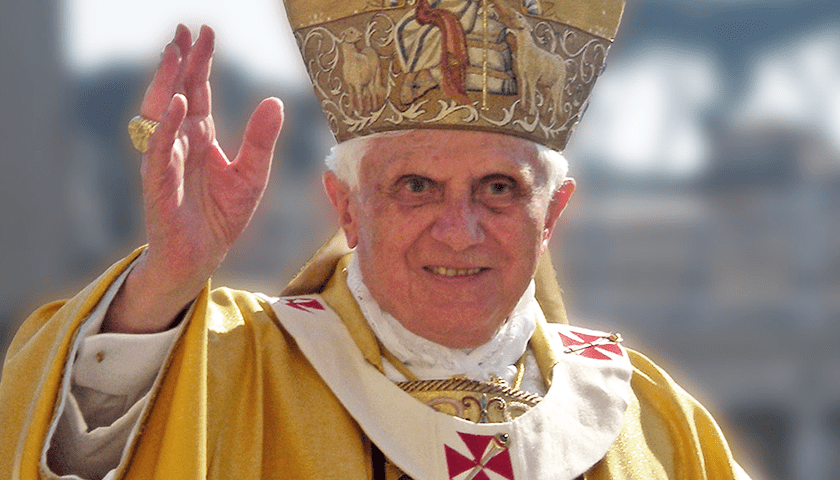by Paul Kengor
A couple of months ago I was in a fascinating conversation with a Catholic colleague regarding the papacies of Pope Benedict XVI and Pope Francis, here in the ninth year of this curious era, 2013-22, when the world was living with, in effect, two popes of sorts, a reigning pope named Francis and a resigned pope — a “Pope Emeritus” — named Benedict XVI. We were wondering if the latter would, ironically, ultimately outlive the former, who few expected to have a papacy this long. When Francis’ papacy started in 2013, he was already known for poor health, which has progressively gotten worse.
Indeed, my good friend and colleague John Gizzi at Newsmax reported this time last year (December 2021) that Vatican officials were expecting the death of Francis in 2022. That was not an unreasonable expectation.
Well, here we are, New Year’s Eve 2022, and Pope Francis is heading into the tenth year of his papacy, and with no questions remaining about whether the world lives under the confusing situation of “two popes.”
Pope Emeritus Benedict XVI died at 9:34 a.m. Rome time at age 95.
But confusion still reigns. It started when Pope Benedict baffled the world by resigning on February 11, 2013. His resignation, the first of a pope in six centuries (since Gregory XII in 1415), gave rise to the papacy of Jorge Bergoglio, which has been a papacy that has sowed a vast sea of confusion among the faithful and even non-faithful who no longer can look to the Holy See for the consistency it has been renowned for. It was a papacy that I used to frequently defend, including in a lengthy piece for Crisis Magazine in March 2019, but which I can no longer defend given Francis’ unending stream of mixed signals and contradictions and outright outrages. Pope Francis’ papacy, I regret to concede, has been a disaster. At a time when the world has desperately needed a papacy of clarity, which it had under Benedict, it has gotten a papacy of chaos.
My friend and I back in October talked about that and about the growing phenomenon of conservative Catholics who loved Benedict now bitterly blaming him for the chaos of Francis. After all, it was Benedict who resigned and hence made Francis possible.
Point taken. But it is also true that we mere mortals have no idea of precisely the reasons why Benedict stepped down in February 2013. He was an extraordinarily thoughtful, theological, prayerful, humble, and plainly brilliant man. Only he and God alone knew his full reasoning. Perhaps the man had some sort of private revelation that prompted his action.
That said, we do know this: lighting literally struck the Vatican twice just hours after Benedict resigned. Was this a sign of heavenly disapproval? Perhaps a signal from above of the chaos to come? Surely this was a troubling sign of some sort.
I’ve been asked many times at various points since Cardinal Joseph Ratzinger became pope in April 2005 to offer my assessment of the man. To me, what will always stand out the most — aside from his resignation and those striking thunderbolts — was his opening statement just prior to being chosen pope.
In his final homily after the death of John Paul II, given just before the College of Cardinals convened, Cardinal Ratzinger called out a “dictatorship of relativism.” What prompted those words were the readings that day, April 18, 2005. He was quoting Ephesians 4:14, where St. Paul warned of people being “tossed here and there, carried about by every wind of doctrine.” As Ratzinger noted with exclamation, “This description is very timely!” He explained:
How many winds of doctrine have we known in recent decades, how many ideological currents, how many ways of thinking. The small boat of the thought of many Christians has often been tossed about by these waves — flung from one extreme to another: from Marxism to liberalism, even to libertinism; from collectivism to radical individualism; from atheism to a vague religious mysticism; from agnosticism to syncretism and so forth. Every day new sects spring up, and what St. Paul says about human deception and the trickery that strives to entice people into error (cf. Ephesians 4:14) comes true.
Today, having a clear faith based on the Creed of the Church is often labeled as fundamentalism. Whereas relativism, that is, letting oneself be “tossed here and there, carried about by every wind of doctrine,” seems the only attitude that can cope with modern times. We are building a dictatorship of relativism that does not recognize anything as definitive and whose ultimate goal consists solely of one’s own ego and desires.
His statement captured powerfully the phenomenon to which many of us have struggled to affix a label, something that might adequately capture the pernicious sophistry of idiotic isms from Marxism to socialism to secular progressivism and various insidious junk that has burst forth into the cultural zeitgeist plaguing our current day.
“If you marry the mood or the spirit of the age,” warned Bishop Fulton Sheen, “then you will be a widow in the next one. These fashions simply do not last.”
No, they don’t. Benedict realized that. But he also realized that they last long enough in each era — and always rapidly supplanted by another destructive ism anew — to wreak their havoc on human lives.
In fingering the various extremes, Ratzinger fittingly named Marxism first, with a litany of other variants of Modernism following. Yes, every day a new sect pops up, with people so easily deceived. The whole goofy hodgepodge of the LGBTQIA+ movement reveals it distinctly, especially the crucial addendum to that label that I always make sure I add to the logo: the “+” sign.
Indeed, all of these forces are so relativistic — unmoored and un-ruddered and ever-changing by the day. You can literally change your “gender identity” by the hour. Facebook and Google and other cultural mavens no longer bother saying that there are, say, 70-some gender options. They simply now say there are “over 100.” Actually, the options are limitless in the dictatorship of relativism. You’re free to invent anew whichever “gender” choice you would like at any moment. Add the + sign.
As Ratzinger put it, it consists solely of one’s own ego and desires.
Now, we are moving from redefining life in the womb and redefining marriage and redefining gender to the Brave New World of trans-humanism. Hold on to your boat for that one, pilgrim.
So many isms and so many victims, tossed here and there, carried about by every wind of doctrine.
The only solution is not the always shifting winds of moral relativism but the timeless truths and moral absolutes of the Judeo-Christian tradition. Ratzinger recommended just that. Rather than being children tossed about, he recommended “the Son of God, the true man” and an “adult faith” that follows not “the trends of fashion and the latest novelty.”
“All people desire to leave a lasting mark,” stated Ratzinger in that April 2005 homily. “But what endures?… The only thing that lasts forever is the human soul, the human person created by God for eternity.”
We are made in the Imago Dei, the Image of God. We do not make ourselves.
But what a shame that every age apparently must suffer these noxious doctrines. From age to age, they leave victims. Few in the 20th century left as many victims as communism — namely, over 100 million dead. Our 21stcentury is stacking up new victims to new isms in the dictatorship of relativism.
A final observation on the life and thought of Pope Benedict XVI, even as I could say so much more.
The first act of his pontificate really came the moment when Cardinal Ratzinger chose his name: Pope Benedict XVI. In doing so, he was invoking the spirit and challenge faced by Pope Benedict XV (1914-1922), who had tried to save Europe from collapse because of World War I.
By calling himself “Pope Benedict XVI,” Ratzinger was trying to signal that he hoped to reverse the collapse of Europe in a new century, this time due not to the guns of a new “Great War” but the guns of a new atheism and belligerent secularism. Here again, in a new century, Europe was destroying itself. The continent’s Judeo-Christian heritage was under deliberate abandonment. This was not a coerced de-Christianization, as the madmen of the French Revolution had forced, but a voluntary de-Christianization among individuals by their own merrily stupid choice.
Throughout his pontificate, Pope Benedict XVI and his Church faced hostile forces in the West, from angry atheists and intolerant progressives looking to redefine everything from marriage to family to sexuality to gender to life itself — and demonizing faithful believers who disagreed with them. It has only gotten worse.
Benedict also chose his papal motto — a beast of burden — which, looking back in retrospect, was a harbinger of his retirement. That burden overwhelmed him ultimately, and he thus stepped down, giving us the burden of the Francis papacy of chaos.
And now, at the very end of 2022, Benedict has left us, and the world remains ever more awash in a dictatorship of relativism that the current pope and world seem helpless in reversing. Only God can do that. Maybe at long last He will.
Happy New Year.
– —
Paul Kengor is Editor of The American Spectator. Dr. Kengor is also a professor of political science at Grove City College, a senior academic fellow at the Center for Vision & Values, and the author of over a dozen books, including A Pope and a President: John Paul II, Ronald Reagan, and the Extraordinary Untold Story of the 20th Century, The Politically Incorrect Guide to Communism, and Dupes: How America’s Adversaries Have Manipulated Progressives for a Century.
Photo “Pope Benedict XVI” by Jüppsche. CC BY 3.0.





